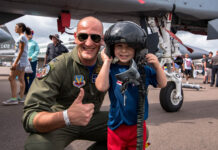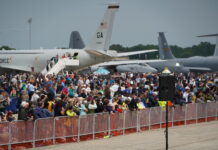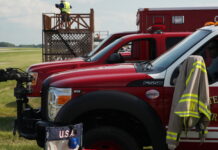Kevin Longfellow is the safest pilot at the air show. You have his word on it.
In conversation, he tells you how much he values safety. His student pilots say how impressed they are by his overtly strong stand on safe air show flying, and the standards he makes them achieve. So, it surprises them to see increasing numbers of occasions where he has been invited to “de-briefings” about his low flying and busting the crowd line. Does he really believe what he preaches?
The answer is yes. He’s not a liar, and he is not arrogant. He firmly believes that he is safe. Deep down, he knows that he occasionally pushes it too far. Each time, he determines that it won’t happen again, and puts it down to a “blip.” He tells himself that at least he usually stays within his own limits, and that is what counts.
Kevin’s death was instant. The aircraft was seen to do two passes, both considerably lower than briefed. A hesitation roll was executed in the first pass, and the wing was said to be just a few feet from the ground on the third quarter. However, it was the slow roll on the second pass that killed him. He momentarily seemed to lose control, there was a hesitation, and the aircraft just seemed to fly straight into the ground. It all happened in seconds. No one can work out why he did it.
“He was one of the finest, and one of the most safety conscious pilots around,” everyone said.
Kevin had recently taken part in a survey from Cranfield University. There were two main questions. The first asked the participant to recall displays in which they had had felt most displeased with themselves, and describe the displeasing events (whatever the reason). The second question was the same, but using the term “pleased” rather than “displeased.” The general method of asking two polar opposite types of questions is called the “critical incident technique,” and was invented by U.S. Army Air Force scientists after World War II.
For question one, Kevin wrote about a display with which he had originally been happy, until he watched a video replay and realized that key maneuvers had been obscured by the sun, due to his positioning. On another occasion during the same performance, he had missed a whole section of his performance sequence, and only realized it on landing! For question two, Kevin wrote about a time when he won the “best performance” award that day, despite the authorities changing the boundaries of the display area that morning, meaning he had to ad-lib part of his routine.
A few weeks later, Kevin received another survey by e-mail. This time, the question was quite different. It simply stated; “Describe the time when you think you came closest to having an accident while flying at an air show.” Kevin had had several “near accidents” at air shows. He wrote about a time where he had taken off with his altimeter mis-set by 1,000 feet (after a large pressure change overnight). He had pulled through from inverted flight, realized his error too late, and missed the ground by “inches.” A video from the crowd showed how lucky he had been.
Kevin is fictitious. The survey was real, however (although a little more detailed), and Kevin’s responses are based on real ones, and are typical of most participants. Seventy five pilots from 10 different countries took part.
Analysis of the responses showed that answers to question one (displeased) tended to center around how the pilots think the display was perceived by others (appearance, entertainment value, etc.), disappointment about the actual event not living up to their expectations, and event organization being poor. Answers to question two (pleased) tended to focus around satisfaction with the pilots’ abilities and also rewards, such as crowd comments, peer recognition, prizes, etc. A few pilots mentioned safety, particularly safe modification of a plan. Responses to question three showed that most pilots had had a “near accident” which was attributable (at least partly) to their own actions.
The Cranfield researchers looked at the relationship between the answers to question one (most displeased with a particular performance) and question three (closest to having an accident). The hypothesis was that if pilots value safety above all else while flying air shows (as they themselves often state), then each answer to Question #1 should be repeated in Question #3. Put another way, the performance at which pilots were most displeased with their performance should be the same as the performance during which the pilot came closest to having a fatal accident. Indeed, the survey even said, specifically, that the same events could be used.
However, for most, there was no correlation. The survey showed that, for 90 percent of air show pilots responding to the survey, the event that they said was the closest they’ve come to having an accident, was NOT the same one that they were most displeased with. Almost all pilots related a story about coming close to crashing through their own hand, and, of those, most were not events that had been written about in the previous questions.
What conclusions can we draw?
The survey showed that whereas most pilots consciously believe that safety is their top value, it is not treated as such by his air show “persona.” That is, when Kevin is in the role of “air show pilot,” he is prepared to allow the performance element to trump the safety element (probably without consciously realizing it).
A famous experiment by Dr. Phillip Zimbardo, of Stanford University, showed that people will act in ways that are totally unrecognizable, and yet they are not aware of it at the time. Zimbardo randomly selected students to be prisoners and guards, and then put them in these roles in a realistic prison (built at the University) and simply sat back and observed… for two weeks. Actually, the experiment was stopped before a week was out because the guards had become extremely abusive, and the prisoners depressed and helpless. The point of interest is that, when in their “roles,” the participants took on different values and personalities, which felt completely “normal” to them at the time, and unrecognizable afterwards. This type of experiment has been oft repeated and shows the power of circumstances in changing the way we behave, exhibiting very uncharacteristic and unrecognizable behaviour, until pointed out to us afterwards.
This should ring alarm bells for all air show pilots. Do you know who is flying your airplane in the air show? It’s not quite the same person you see in the shaving mirror, or in the reflection of the window of the briefing room. That guy takes risks you wouldn’t take, flies lower than you would fly, and will generally decide to do that extra roll, Cuban, loop or inverted pass, even if you would recommend against it.
If you have ever looked back on an air show performance and felt that you did something you probably shouldn’t have, then you are normal. The challenge is to educate the guy who flies your airplane, not the guy reading this; he never goes near your aircraft. l








